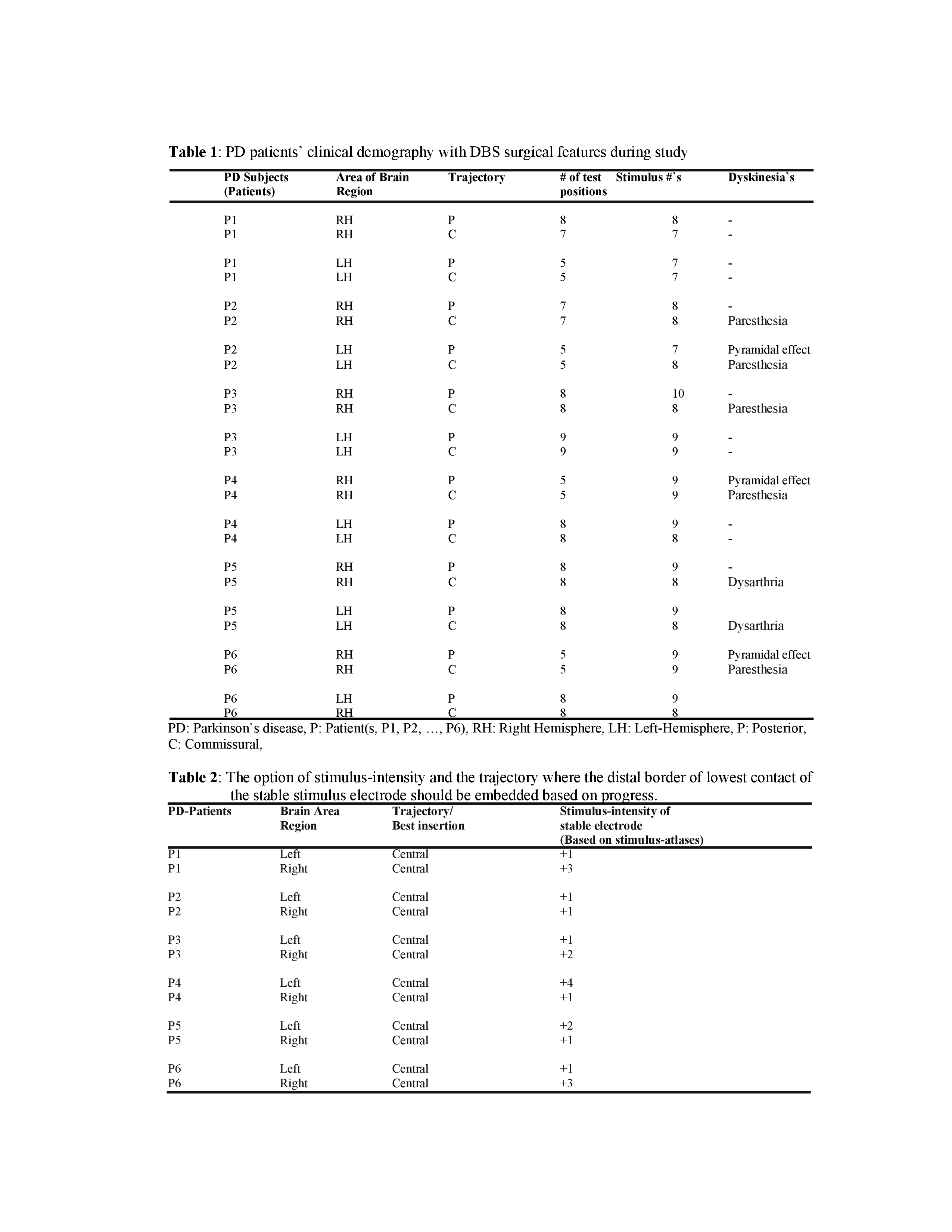Category: Surgical Therapy: Parkinson's Disease
Objective: The objective is to examine the microrecording(MER, intra operative) and differentiate stimulus induced micro lesion effect on cardinal motor features of Parkinson’s disease.
Background: DBS is a surgical—method for movement disorders. Stimulus-electrode-site in PD brain is a key point for successful medical-administration. Ample assessments of aptness and dysarthria`s and dyskinesia’s (adverse and side-effects) of stimuli on singular-points especially for varied-amplitudes are intra-operatively achieved. Yet, the information has to be examined carefully for choosing the best-stimulus-point (optimal-site) of the electrode as fluctuations, measured to signify collective neuronal-discharge from neurons surrounding the electrode. This study introduces a novel stimulus atlas procedure.
Method: Pre and intra operative MER signal recording was performed. PD key features were assessed as per the UPDRS in the pre op “OFF” state. All subjects were scanned with MRI encompassing 1mm T1-weighted axial images, with and without gadolinium, and 2mm T2 weighted axial-images. The STN was detected by direct targeting T2 weighted image of MR and the trajectory was planned. Surgery planned using a robust CRW frame that has luminant MR localizer.
Results: Electrode induced stimuli micro lesion effect was assessed based on dissimilarity among tremor, Bradykinesia and rigidity scores in the pre op “OFF” state and intra op MER “ON” state prior to stimuli. The induced micro lesion effect progressed motoric-features but uncorrelated with the electrodes. Zenith advance area is often in the STN posterior area.
Conclusion: Out of the 12 stimulus-atlases, 9 found to be the highest enhancement area was in posterior or lateral subthalamic(PSA/LSA) area in pact with the exact consent and evidence methodically. LSA is mediocre to the ventro-intermedius-nuclei which include pre lemniscal radiations but unexplored in other three atlases as dysarthria was examined in this site at low stimuli. Microrecording induced lesion effect on cardinal manifestations of Parkinson’s disease during STN-DBS operational procedure is most significant for clinical implications. Surgical-significance — this retrospective study utility tool of the stimulus atlas is useful for discovering the optimal electrode site to implant in a diseased brain prognostically.
References: 1. V. Rama Raju, Rukmini Kandadai Mridula & Rupam Borgohain (2019): Effect of Microelectrode Recording in Accurate Targeting STN with High Frequency DBS in Parkinson Disease, Taylor & Francis IETE Journal of Research , Vol. 65, No. 2, Pp: 1-14, Mar-Apr 2019. DOI: 10.1080/03772063. 2019. 1592715, March 2019. Published online: 26 Mar 2019. 2. Shah A, Coste J, Lemaire J-J, Taub E, Schüpbach WMM, Pollo C, Schkommodau E, Guzman R, Hemm-Ode S (2016) Intraoperative acceleration measurements to quantify improvement in tremor dur-ing deep brain stimulation surgery. Med Biol Eng Comput 55(5): 845–858. https://doi.org/10.1007/s11517-016-1559-9
To cite this abstract in AMA style:
V. Ramaraju. Objective study of intra operative test for discovering optimal electrode site for effective imaging and bilateral STN-DBS stereotactic functional neurosurgery [abstract]. Mov Disord. 2020; 35 (suppl 1). https://www.mdsabstracts.org/abstract/objective-study-of-intra-operative-test-for-discovering-optimal-electrode-site-for-effective-imaging-and-bilateral-stn-dbs-stereotactic-functional-neurosurgery/. Accessed April 26, 2025.« Back to MDS Virtual Congress 2020
MDS Abstracts - https://www.mdsabstracts.org/abstract/objective-study-of-intra-operative-test-for-discovering-optimal-electrode-site-for-effective-imaging-and-bilateral-stn-dbs-stereotactic-functional-neurosurgery/

